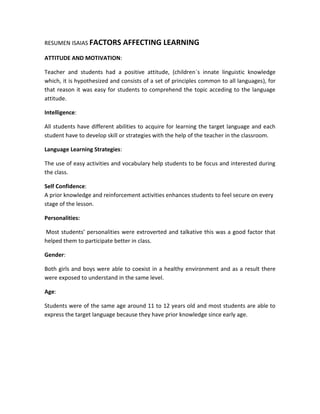
FACTORS AFFECTING LANGUAGE LEARNING
- 1. RESUMEN ISAIAS FACTORS AFFECTING LEARNING ATTITUDE AND MOTIVATION: Teacher and students had a positive attitude, (children`s innate linguistic knowledge which, it is hypothesized and consists of a set of principles common to all languages), for that reason it was easy for students to comprehend the topic acceding to the language attitude. Intelligence: All students have different abilities to acquire for learning the target language and each student have to develop skill or strategies with the help of the teacher in the classroom. Language Learning Strategies: The use of easy activities and vocabulary help students to be focus and interested during the class. Self Confidence: A prior knowledge and reinforcement activities enhances students to feel secure on every stage of the lesson. Personalities: Most students’ personalities were extroverted and talkative this was a good factor that helped them to participate better in class. Gender: Both girls and boys were able to coexist in a healthy environment and as a result there were exposed to understand in the same level. Age: Students were of the same age around 11 to 12 years old and most students are able to express the target language because they have prior knowledge since early age.
- 2. ARGUMENTATED CONCLUSION: During the process of the class the lessons were taught inspired in constructivism and conginitivism theories. The facts are the ways teacher uses with the students and how it was developed in the different stages. Constructivism: Is a theory to explain how the learner constructs their own knowledge using their previous knowledge that they have been developed by experiences. Cognitivist: Is the theory that describes how information is processed to produce learning, it is a change in a learners` mental behavior. According to Paget constructivism is a need for accommodation when current experience cannot be assimilated in exiting schema (Piaget 1977, in cognitive stage called concrete operatorial that is in the age of 6/7 to 11/12 years old children who begins to think logically. We observed that the class was inspired in the communicative approach because the class was exposed in the target language. Students and teacher interacted in the second language. This is based on the below definition of this approach. (The communicative approach is based on the idea that learning language successfully comes through having to communicate real meaning. When learners are involved in real communication, their natural strategies for language acquisition will be used, and this will allow them to learn to use the language.) The students were capable to understand languages without using their mother tongue. According to Chomsky`s theory (Universal Grammar) language acquisition is based on the hypothesis that innate knowledge of the principles of Universal Grammar (UG) permits all children to acquire the language of their environment, during a critical period in their development. (Critical Period is based in if a language is not learned by puberty the biological endowment which permits successful language acquisition will not be available. It will be more difficult and incomplete after puberty.) http://www.teachingenglish.org.uk/knowledge-database/communicative-approach British Council, 10 Spring Gardens, London SW1A 2BN, UK © BBC World Service, Bush House, Strand, London WC2B 4PH, UK. We observed that during the lesson there were some factors that were favorable according to the critical period hypothesis were: Motivation and Attitude: Positive attitude and motivation are related to success in second language learning (Gardner 1985) Students show a good attitude although there
- 3. was lack of motivation. According to the affective filter hypothesis that arguments that if the filter is up the input is blocked and if the filter is down the input is positive. (Steven Krashen). Intelligence: Is important to keep in mind that “intelligence is complex” and that individual have different kind of abilities and straights, not all of which are measured by traditional IQ test. Language Learning Strategies: Learning Strategy or style are terms to describe identify individual approach to learner situations: Specifically, Keefe(1979:4) defined them as “cognitive, affective and psychological traits that are relatively stable indicators of how learners perceive, interact with, and respond to leaning environment”. Self Confidence: Krashen, claims that learners with high motivation, self-confidence, a good self-image, and a low level of anxiety are better equipped for success in second language acquisition. Personalities: Are the characteristics of a person as self-teem, empathy, dominance, talkativeness, and combines with other factors that contribute to second language learning. Age: The critical period hypothesis suggests that there is time in human development when the brain is predisposed for success in language learning. Developmental change in the brain it is argued, affect the nature of language acquisition. Gender: Children`s innate linguistic knowledge which, it is hypothesized consists of a set of principles common to all languages. How the material promotes SLL Such a procedure can provide comprehensible input of course, but- given a meaningful context, learners can comprehend the general meaning of many forms which they certainly have not “mastered”, and indeed, may never have produce. Thus, restricted classroom second language material to those which contain little or nothing which is new may have several negative consequences. Also input hypothesis was applied because according to krashen assert that one acquires language in only one way-by exposure to comprehensible input . (A term introduced by Steven Krashen to refer to language which a learner can understand), because during the class the teacher gave students basic information so that students produce language).